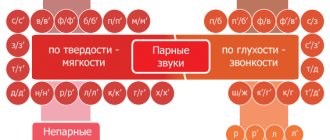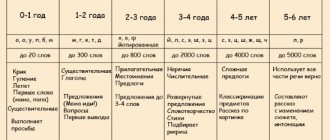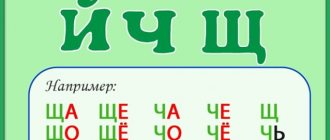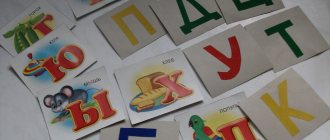- home
- What to do if a child softens his consonants?
/
Have you noticed with your child that he softens his consonants in a conversation? It seems that he is “lisping” like a one and a half year old baby. This is a softening defect. The sooner you seek help from a speech therapist, the better. If the mitigation defect is not eliminated in a timely manner, it manifests itself later in written speech, which leads to new problems and a decrease in school performance. Highly qualified specialists in Zelenograd will provide your child with timely speech therapy assistance.
Educational page
In the pronunciation of consonants having a hard (soft) pair, softening defects are observed
Most consonants in the Russian language have paired soft sounds. The exceptions will be the sounds Ш, Ж, Ц, which do not have soft pairs, and the sounds Ш, Ш, Ж, which do not have hard pairs. Soft consonants differ in articulation from paired hard consonants by an additional rise of the back of the tongue towards the hard palate, some (k'g'h') also by a noticeable movement of the tongue forward. What causes this defect? First of all, muscle tone disorders, the nature of which depends primarily on the location of the brain lesion.
Spasticity of the articulatory muscles - a constant increase in tone in the muscles of the tongue, leads to the fact that the tongue is tense, pulled back, its back is curved, raised upward, the tip is not pronounced.
Phonetic alternations of consonants by hardness/softness
Indication of hardness/softness of consonants in writing
The hardness/softness of consonants as an independent feature, and not one arising due to positional changes, is fixed in the following strong positions: 1) before vowels, including [e]: [lu]k bow - [l`u]k hatch, [but]s nose - [n'o]s carried, pastel pastel - after [t'e']l bed;
Paired soft consonants before [e] are pronounced in native Russian words, paired hard consonants are pronounced in borrowed ones. However, many of these borrowings have ceased to be recognized as rare: antenna, cafe, sausage, stress, mashed potatoes, prosthesis, etc. As a result, in common words it has become possible to pronounce both hard and soft consonants before [e]. 2) at the end of the word: ko[n] kon - ko[n`] horse, zha[r] heat - zha[r`] fry; 3) for the sounds [l], [l`], regardless of their position: vo[l]ná wave - vo[l`]ná is free; 4) for consonants [c], [s`], [z], [z`], [t], [t`], [d], [d`], [n], [n`], [ р], [р`] (for front-linguals) - in the position before [к], [к`], [г], [г`], [х], [х`] (in front of back-linguals): gó[р] ka hill - gó[r`]ko bitter, bá[n]ka bank - bá[n`]ka bathhouse; - in the position before [b], [b`], [p], [p`], [m], [m`] (before labials): i[z]bá izba - re[z`]bá carving. In other cases, the hardness or softness of a consonant will not be independent, but caused by the influence of sounds on each other.
Similarity in hardness is observed, for example, in the case of combining soft [n`] with hard [s], cf.: kó[n`] horse - kó[ns] horse, Spain [n`]ia Spain - spain[ns] cue (i.e. [n`] // [n] before hard). The pair ju[n`] June - ju´[n`s]ky June does not obey the indicated pattern. But this exception is the only one.
Assimilation by softness is carried out inconsistently in relation to different groups of consonants and is not observed by all speakers. The only exception is the replacement of [n] with [n`] before [h`] and [w:`], cf: drum[n] drum - drum[n`ch`]ik drum, go[n]ok races - gó[n` sh:`]ik racer (i.e. [n] // [n`] before soft).
In accordance with the old norms, one should say: l ya´[m`k`]and straps, [v`b`]to drive in; [d`v`]open the door; [s`j]eat; [s`t`]ená wall. In modern pronunciation there is no obligatory softening of the first sound in these cases. Thus, the word la´[mk`]i straps (similar to trya´[pk`]i rags, lá[fk`] and benches) is pronounced only with a hard word, other sound combinations allow for variability in pronunciation.
The designation on the letter applies only to cases of independent, and not positionally determined hardness/softness of paired consonants. At the letter level, the soft quality of the sound [n`] in the words drum and racer is not recorded graphically.
In contrast to deafness / sonority, the independent softness of paired consonants is conveyed not by the letter corresponding to the consonant sound, but by the letter following it: the letters i, е, ю, я: face, ice, hatch, clang;
In modern language, the letter e no longer denotes the softness of the preceding consonant. The combination of letters ...te... cannot be read if you do not see which word it belongs to - dough or test. 1) at the end of the word there is a soft sign: horse, fry, dust; 2) in the middle of the word, before the consonant, there is a soft sign: darkness, very, bathhouse.
The independent hardness of paired consonants is conveyed by the following means: the letters s, o, u, a, e: bast, boat, bow, weasel, karate; at the end of the word there is no soft sign: con_, heat_, dust_l; in the middle of a word before a consonant there is no soft sign: t_ min, s_ looks, bank_ ka.
The hardness/softness of unpaired consonants does not require a separate designation. The spelling i/y, e/o, yu/u, ya/a after the letters w, zh, ch, sch, c, corresponding to unpaired ones, is dictated by tradition: life, number, chicken, burn, burn, joke, brochure, cup. The same applies to the use/non-use of the letter soft sign in a number of grammatical forms: rye, married_, quiet, baby_, thing, comrade_, can, brick_.
Mom will be a speech therapist
To know which sound to start with, you need to consider:
- What sounds does the child pronounce most perfectly in order to obtain from them, based on the ready-made structure, the correct sound of a paired defective sound;
- The structure of which sounds allows you to most demonstrably show the difference between the articulation of paired hard and soft sounds.
The consonant sounds T, D, N are simple in their structure, therefore they are rarely defective and, in addition, are pronounced with half-open teeth and lips, which makes it possible to see changes in the position of the middle part of the tongue during the transition of the sound T to Т, Д к Дь, Н к NH. Thus, the selected sounds satisfy both conditions.
If you put two fingers (middle and index) on your tongue, you can feel the change in tongue tension tactilely.
In difficult cases, you can temporarily resort to mechanical help: offering to pronounce the syllables AT or TA repeatedly with the tongue resting on the lower teeth, lightly pressing with a finger or a spatula on the tip of the tongue. This will soften the sound T, that is, the syllables AT, TYA. By analogy, you can get the syllables AN, NYA, DYA.
While working with the sounds T, D, N, a kinesthetic feeling of tension and relaxation of the tongue should be developed, thanks to this, similar work on other sounds will be much easier and faster, but it is still necessary to check the correct pronunciation of the hard and soft pairs of all consonants.
Exercises to correct softening of consonant sounds
To correct the sound softening defect it is necessary
exercise more often
“Pussy is angry”, “Reel”, “Slide”, “Pushing the ball with our tongue.”
Exercise “Pussy is angry”
The mouth is open. Lips in a smile. The wide tip of the tongue rests on
base of the lower incisors. The back of the tongue arches, then
leveled out. Make sure that the tip of your tongue does not leave your teeth.
the tongue did not narrow, the lips and lower jaw were motionless.
Repeat 5 times.
Exercise "Reel"
The mouth is open. Lips in a smile. The wide tip of the tongue rests on
base of the lower incisors. The lateral edges of the tongue are pressed against
molars. The wide tongue “rolls out” forward and retracts
deep into the mouth. Make sure that the tongue does not narrow, the lateral edges of the tongue
slid over the molars, the tip of the tongue did not leave the incisors,
the lips and lower jaw were motionless. Repeat 5 times.
Exercise "Gorka"
The mouth is open. Lips in a smile. The wide tip of the tongue rests on
lower incisors, and the anterior-middle part of its back first
rises until it touches the upper incisors, then
falls. Make sure that your lips do not stretch over your teeth,
the lower jaw did not move. Repeat 5 times.
Exercise “Pushing a ball with your tongue.”
The mouth is open. Lips in a smile. The wide tip of the tongue rests on
base of the lower incisors. Place the ball on a stick behind the front
lower teeth, and the tongue pushes it, trying to push it out.
Tom and Tim.
Once upon a time there were two brothers. One was named Tom. He was thin, tall, and as hard as the T that began his name. He always chose for himself something that started with solid sounds. He loved juice and crackers. He wore a coat and never wore a jacket. He did not take the ball, but he willingly blew soap bubbles and played sea battle. And the second brother, whose name was Tim, was soft, plump, round. He loved everything that began with soft sounds, like his name: meatballs, pies, cakes, jelly, candy. The brothers were very friendly. When Tim drew, Tom painted. If Tom picked up a pipe, then Tim picked up a guitar. They never chose the same items, so they didn't quarrel. They didn't have to snatch toys and sweets from each other. One day the brothers decided to go traveling. Let's help them get together. (Classification of things according to the first sound, hard or soft?) We clarify who will take the satchel, backpack; who needs a pot, bowl, fork, spoon, knife: who loves milk, kefir, kalach, pie, sausage, ham; who puts on sneakers, sneakers; whichever brother puts a hat on his head takes it; who will go to the forest, and who to the meadow; who will collect what mushrooms (russula, chanterelles, boletus, saffron milk caps, boletus, boletus)? It's time to make a stop. Who brought branches and who brought dead wood? The brothers decided to catch fish. Who will fish in the pond, who in the river? Who will catch the bait with catfish, gudgeon, roach, bream, tench, carp.
To know which sound you should start working with, you need to take into account: 1) The child’s pronunciation of which sounds is most perfect in order to receive from them, based on the ready-made structure, the correct sound of a paired defective sound; 2) Which sounds make it possible to most demonstratively show the difference between the articulation of paired hard and soft sounds. The consonant sounds T, D, N are simple in their structure, therefore they are rarely defective and, in addition, are pronounced with half-open teeth and lips, which makes it possible to see changes in the position of the middle part of the tongue during the transition of the sound T to Т, Д к Дь, Н к NH. Thus, the selected sounds satisfy both conditions. In difficult cases, you can temporarily resort to mechanical help: offering to pronounce the syllables AT or TA repeatedly with the tongue resting on the lower teeth, lightly pressing with a finger or a spatula on the tip of the tongue. This will soften the sound T, that is, the syllables AT, TY. By analogy, you can get the syllables AN-NYA, DYA.
While working with the sounds T, D, N, a kinesthetic feeling of tension and relaxation of the tongue should be developed, thanks to this, similar work on other sounds will be much easier and faster (labial-dental vi, f, then labial p, b, m). As for the sounds k', g' and x', special work on them is usually not required, since in Russian they usually occur only before the vowels and, e (brick, weight, cunning, on the arm, on the leg, about a rooster, etc.) and are acquired in this position (especially before the sound and) without difficulty. This is how Olga Vladimirovna Pravdina recommended eliminating this defect.
Tatyana Borisovna Filicheva recommends correcting this defect as follows: Stage 1: Consolidating the correct pronunciation of the sound Y and distinguishing it from I. Stage 2: Consolidating syllables based on preserved consonant sounds KY-VY-PY-BY, distinguishing these syllables by ear. Stage 3: Clear pronunciation of words with hard consonant sounds (exaggerated): BA - BE, LA - YOU, ... Stage 4: Including words in sentences. Stage 5: We teach the child to clearly pronounce the sound I, introduce the symbol of softness. Stage 6: We provide auditory discrimination of the sounds Y, I. Stage 7: We consolidate clear pronunciation of syllables that include the sound I and a preserved consonant sound (PI-VI-MI). Stage 8: We distinguish the syllables by ear PI-VI-BI and PY-YOU-BE. Stage 9: Give words with soft sounds of sentences with these words. Stage 10: Differentiation of soft and hard sounds. Syllabic exercises with complication are given: PY-PY-PY, PI-PU-PI, PYP-PIP, PA-PYA, PA-PA-PYA with different stress and intonation. Exercises with the ball.
Moneybox of knowledge
Preparatory exercises for correcting a softening defect are arching the middle part of the back of the tongue and lowering it. To develop these skills, articulatory gymnastics exercises “Pussy is angry”, “Reel”, “Slide” are used.
Exercise “Pussy is angry”
The mouth is open. Lips in a smile. The wide tip of the tongue rests on the base of the lower incisors. The back of the tongue arches, then straightens. Make sure that the tip of the tongue does not come off the teeth, the tongue does not narrow, the lips and lower jaw are motionless.
Exercise "Reel"
The mouth is open. Lips in a smile. The wide tip of the tongue rests on the base of the lower incisors. The lateral edges of the tongue are pressed against the molars. The wide tongue “rolls out” forward and retracts deep into the mouth. Make sure that the tongue does not narrow, the lateral edges of the tongue slide over the molars, the tip of the tongue does not come off the incisors, the lips and lower jaw are motionless.
Exercise "Gorka"
The mouth is open. Lips in a smile. The wide tip of the tongue rests on the lower incisors, and the front - middle part of its back first rises until it comes into contact with the upper incisors, then lowers. Make sure that the lips do not stretch over the teeth and the lower jaw does not move.
Speech therapy classes at the Speech Center are a system of classes aimed at correcting violations of all aspects of speech: sound pronunciation, phonemics, grammar, vocabulary, syllable structure.
Speech therapy massage is one of the methods of correctional and pedagogical influence used in the correction of severe speech disorders. This is an unconventional and effective method of correcting sound pronunciation, because Speech therapy massage helps to normalize the pronunciation side of speech, improves the condition of the voice, speech breathing, and normalizes the emotional state of a person suffering from speech disorders.
Primary school “Healthy childhood” as a complete and additional education
Hurry up to sign up! Registration is open!
Dear mothers! We are pleased to inform you that you can attend the “Healthy Childhood” Primary School not only as a full-fledged education, but also as an additional education!!!
If you understand that your child is not coping with school, then the Speech Center is ready to come to your aid! You can attend the “Healthy Childhood” Primary School in your own way as additional education (help with learning difficulties, tutors, wellness).










